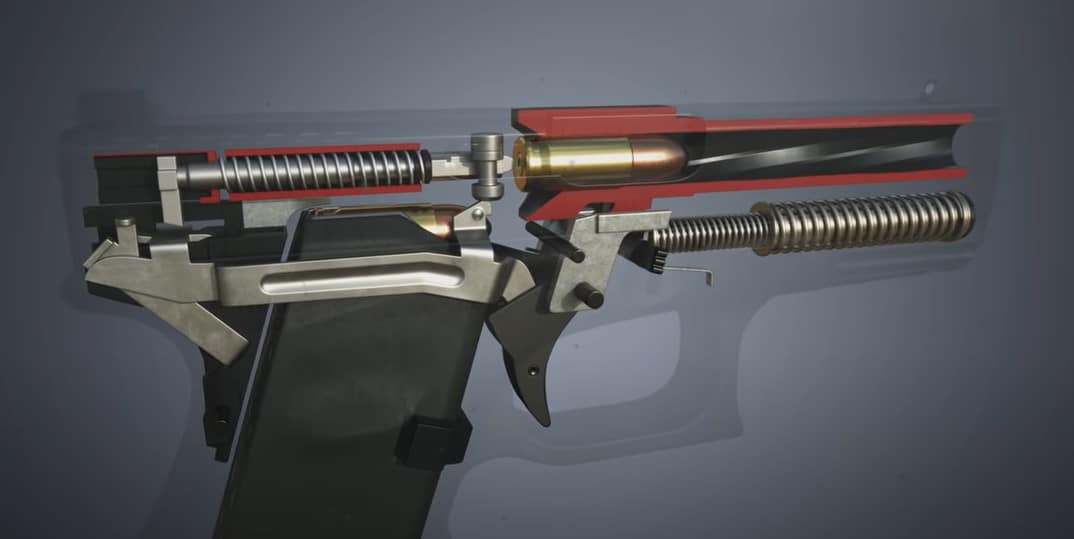How A Glock Safety Works?

The Glock is a series of semi-automatic pistols that are designed and produced by Austrian manufacturer Glock Ges.m.b.H.
It is known for its unique polymer frame, short recoil, and their trademark “safe action” safety system. It was the top performer in the reliability and safety tests and thus entered the Austrian military and police service in 1982.
Due to the huge popularity of the Glock semi-automatic pistols, they are used by all sorts of characters for all sorts of reasons.
If you read thriller novels, you can probably remember times when a character in a story turned off the safety in a Glock semi-automatic pistol. Well, the writers didn’t do their research properly as you can’t turn the safety off in a Glock.
So, does it mean that the Glocks have no safeties? Well, not really. Despite being famous for their simplicity, 99% of the Glock handguns use three safety mechanisms.
Understanding How Glock Safety Works
It is very unlikely that the Glock will fire unless you pull the trigger, even though it does not have a manual safety. A holster that covers the trigger is the best safety for a Glock. A Glock is equipped with three passive safety features that prevent the gun from firing if it is dropped or handled roughly.
The safeties included in a Glock handgun are trigger safety, drop safety, and firing pin safety. None of them can be switched off at any point by any characters.
The Glock had some reliability concerns when it was first released in the market because of the polymer frame. Concerns regarding security also emerged as the polymer frame could, in theory, circumvent the metal detectors in airports.
However, Glocks have made their place as the company’s most profitable line of products in the military, police, and even civilian sectors.
How Does the Glock Safe Action System Work?
It is always important to place safety first when it comes to firearms, including Glock handguns. This keeps Glock ahead of the competition. Glock handguns feature the Glock Safe Action System as one of their most crucial safety features.
Users should be able to exert the same amount of force to achieve consistent results when using the Glock Safe Action System, which provides a consistent trigger pull weight.
In the Glock Safe Action System, three separate safety controls are integrated into the control system, which allows users to concentrate completely on shooting without having to disengage the safety after each round. Even if you drop your Glock, the Safe Action System ensures its safety.
Safety Features in Glock Explained
The Glock semi-automatic pistol is also sometimes referred to as Glock “safe action” pistol due to its three passive safety features. These features are Trigger safety, Firing pin safety, and Drop safety.
These three systems are engaged immediately when the pistol is at rest, which means that any chance of accidental discharge when dropped is eliminated. We can take a closer look at how each of these safety systems works.
1. Trigger Safety
The first protection that comes with a Glock semi-automatic is the trigger safety. It is attached to the trigger as a secondary trigger. It blocks the trigger’s movement path when it is active. For the pistol to shoot, both the trigger and the safety need to be pressed at once. The gun will not fire if the trigger protection is not forced along with the trigger.
This safety mechanism was made popular by Glock, but it was originally used in 1897 in Iver Johnson Second Model Safety Hammerless revolver. The design of the trigger-security is to thwart the pistol from shooting in case of an accidental drop. Basically, when the trigger is not pressed, the gun deliberately will not fire.
2. Firing Pin Safety
Firing Pin Security hinders the travel path of the firing pin by inserting an automatic block in front of it when the gun is at rest. The mechanical block is directly connected to the trigger machinery. When you let go of the hammer or striker, it clears the obstacle in front of the firing pin.
The firing pin protection in Glock semi-automatic pistols automatically impedes the gunfire pin from proceeding onward in the ready-to-shoot state.
When the trigger in the gun is pulled back, the firing pin security is pushed up by the trigger bar which frees the channel of the gunfire pin. The safety system automatically restarts if you choose not to pull the trigger.
3. Drop Safety
Drop safeties are typically passive securities intended to lessen the possibility of a weapon inadvertently firing when you drop it from your hand or handle it roughly.
Drop safety is a specific requirement in the State of California, along with many other jurisdictions. These types of safeties usually provide some sort of obstacle that is removed only when you pull the trigger.
In the Glock, the trigger bolt, that lies on the protection slope within the trigger machine-covering, occupies the hindmost portion of the shooting pin and stops the firing pin from proceeding forward.
When you pull the trigger on the gun, the trigger bar drops the security slope down, which allows the firing pin to be released. The trigger bar goes up after the shooting which again activates the firing pin. All safeties are automatically reactivated after releasing the trigger.
Safety First With The Glock Safe Action System
Listed below are some of the most important points that all Glock Safe Action System users should keep in mind.
Despite the fact that safety comes first with all firearms, there are ways to prioritize safety without limiting users’ firing rates or capacities. With the Glock Safe Action System, Glock has accomplished this.
By having three separate mechanical safeties, the redundancies help ensure everyone’s safety. As part of this safety system, you will be protected against drops, changes in temperature, and changes in pressure.
In addition to going above and beyond, the Glock Safe Action System proves why Glock is one of the most trusted brands in the industry.
Trigger Reset And Firing Sequences For The Glock
There are several unique features accompanied by the Glock Safe Action System, but trigger reset is one of the most important. If the trigger is only moved forward a small amount, the trigger will reset.
A second shot can be fired without completely releasing the trigger. The gun remains safe despite this. It is just a matter of releasing the trigger slightly if the user wants to fire several shots at once. In this way, the gun can reset, which is felt by the user.
All three safety features in the Glock Safe Action System are reset when the trigger is moved forward, ensuring everyone’s safety without interfering with the firing sequence unnecessarily. It is one of the main features that distinguishes Glock from other firearms.
Gun Safety vs. Being Gun Safe
The purpose of gun safety is not to prevent the firing of the gun but rather to prevent accidental discharge.
Misuse of a gun can result in dangerous situations that can often lead to fatal incidents. There are four basic rules that you should always keep in mind before handling or owning a gun.
- You should always treat a gun as if it is loaded.
- Never point a gun at anything that you don’t want to destroy.
- Keep your finger off the trigger until you are ready to fire.
- Always be aware of your target and what is beyond it.
Why Is Gun Safety Important?
Gun violence in the United States results in tens of thousands of deaths every year, and a large chunk of that comes from accidental discharge of firearms.
This is why it is important for guns to have safety features to reduce the chance of any sorts of accidents. You need to remember that this equipment can be fatal in the wrong hands, so some precautions are always advised.
Safeties can usually be divided into two subtypes, which are internal safeties and external safeties. Internal safeties don’t typically receive any input from the user; hence, they are also known as passive safeties.
External safeties require user inputs like toggling an on/off lever. External safeties are also known as active safeties.
There are many variants of safety mechanisms available in different types of guns. Some common types include a manual safety, grip safety, drop safety, etc.
There is also an indicator in most guns to show if a live round is in the gun chamber known as the Loaded Chamber Indicator or LCI in short. Remember that all mechanical devices can fail eventually, and a gun is no exception to that rule.
You should always keep your guns stored in a place not accessible by everyone, especially children. You should not keep them loaded with ammunition under any circumstances.
It is better to have them locked up in a safe away from others. Though almost all modern guns come with some type of safety mechanism, it is recommended not to carry any weapon unless you have proper training.
Parting Shots
When it comes down to the safety in a firearm, the one holding the gun matters more than the features that come with the gun.
Glock, with its many safety features, is not truly safe in the hands of an untrained individual. So, it is important always to be wary of your surroundings when operating a gun, whether it is loaded or not.
When needed, the Glock Safe-Action trigger is fast and easy to operate, preventing the gun from firing ‘on its own’. The only safety issue is human negligence when the trigger is protected by a holster.

